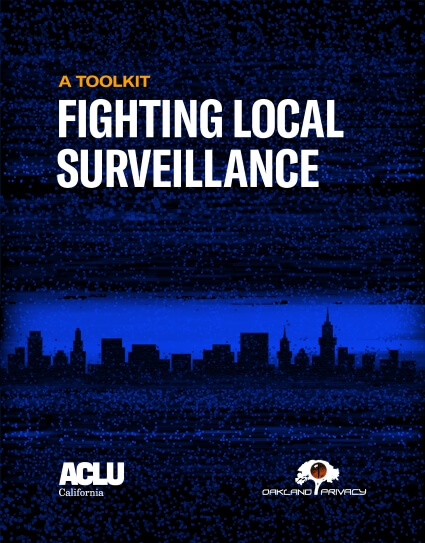Article Media

You can fight government surveillance
In 2019, San Francisco passed a landmark law banning government facial recognition and requiring public oversight for local decisions related to the acquisition and use of other surveillance technologies such as cameras, drones, and more. That effort, led by the ACLU in deep partnership with civil rights partners, is part of a bigger movement afoot in the U.S. In more than a dozen cities and counties, communities have passed laws ensuring that decisions about high-tech surveillance are made by the community through the democratic process, not in secret by police and surveillance companies acting alone.
You can stop secret surveillance in your community, too.
Together, we are achieving important victories against secret and dangerous surveillance. We are raising awareness of how surveillance technology like drones, stingrays, and facial recognition exacerbate discriminatory policing, suppress dissent, and facilitate harm to immigrants and people of color. We are building the political coalitions and power essential to win surveillance reform and durable social change. We are changing the narrative by explaining why surveillance systems make us less safe and less free. We hope you’ll join us.
This toolkit shows how to spark a movement and win lasting change.
This Toolkit summarizes many lessons we have learned about how to work effectively together and fight against local surveillance. It builds on the ACLU of Northern California’s report, Seeing Through Surveillance: Why Policymakers Should Look Past the Hype, and more than a decade of work with partners in California and around the country to pass local and state surveillance laws and chart a path to reform.
This toolkit is a resource for your surveillance reform campaign.
Change is never easy to achieve, but this Toolkit describes the methods and strategies you can use to uncover local surveillance programs, organize and build political power around issues of surveillance, and effectively push for policy and legal reforms. The accompanying Appendix (available online at https://www.aclunc.org/surveillancetoolkit) contains dozens of sample documents, letters, and other materials you can customize for your own surveillance reform campaign.
We hope you use this resource to fight unaccountable surveillance and protect the civil rights of everyone in your community.
Fighting Local Surveillance: a Checklist
PDF Here
- FOCUS ON THE HARMS OF SURVEILLANCE
Your focus should be on the threat that surveillance technology poses, not only to our rights and liberties but also our ability to live safe lives and organize for social and political change. Part 1 seeks to frame the harms of surveillance technology in terms of its real life impacts. For more information, please see our companion report, Seeing Through Surveillance: Why Policymakers Should Look Past the Hype, and the Appendix.
- LEARN ABOUT SURVEILLANCE TECHNOLOGY IN YOUR COMMUNITY
There are several ways to uncover government surveillance in your neighborhood. Part 2 summarizes steps you can take to learn about the surveillance technologies being used by local authorities. Strategies explained include monitoring public agendas posted by local government, close scrutiny of local news, questions to elected officials or government agencies, and public records requests. You can find a sample, customizable public records request in the Appendix.
- BUILD A COALITION FOR POLITICAL CHANGE
A coalition helps you build political power, persuade elected leaders, and achieve durable social change. Part 3 explains how to build an effective coalition that centers on the people most directly impacted by government surveillance. In building a coalition, seek input, inclusion, and leadership from people of color, immigrant communities, low-income or homeless individuals, people on parole, and other local activists.
- CHOOSE A STRATEGIC GOAL TO PURSUE
There is no one-size-fits-all solution for challenging surveillance in your community. Part 4 discusses various legislative and policy solutions you might consider, including a surveillance technology oversight ordinance, a ban on a particular technology (such as facial recognition), a privacy advisory commission, or opposition to a specific proposed purchase of surveillance technology. You can find drafts of model legislation in the Appendix.
- IDENTIFY OPPORTUNITIES TO INFLUENCE LOCAL SURVEILLANCE DECISIONS
Identifying the right decisionmakers, including elected leaders and other officials, helps you to know where to focus your advocacy. Part 5 explains how decisions about surveillance are generally made at the city and county level, including the governing bodies and stakeholders you should be aware of as you craft and execute a public campaign.
- DEVELOP YOUR NARRATIVE AND MESSAGING
Public support is key to building consensus around your strategic goal. Part 6 explains how to start a public conversation about the importance of your issue and create a communications strategy that will help people and policymakers understand surveillance technology, its real life impacts, and the reasons why people should support your coalition’s proposed solution. Look to the Appendix for a guide to build a messaging strategy, as well as sample coalition letters of support and op-eds.
- MEET WITH DECISIONMAKERS TO MAKE YOUR CASE
An in-person meeting with local decisionmakers gives you an opportunity to explain the issues, why they matter and their impact on community members, and to ask for support for your coalition’s preferred strategic goal. To make your meeting a success, it is important to prepare and follow through. Part 7 explains how to request and prepare for a meeting, what to bring, and how to ask for support for your solution.
- PUBLICLY ADVOCATE FOR YOUR STRATEGIC GOAL
Public support is key to building consensus around your goal. Part 8 explains how to start a public conversation about your coalition’s strategic goal and present it to decisionmakers at a public meeting. Look to the Appendix for sample public comments, op-eds, and other public advocacy materials.
- OVERCOME CHALLENGES, BUILD ON YOUR PROGRESS
You will encounter challenges, but you can overcome them. And when you win, celebrate your victory. Build on the progress you achieve, using it as an opportunity to reiterate your coalition’s values and vision for social change. Part 9 discusses how to overcome challenges, achieve your strategic goal, and build on victory for larger social change.
Fighting Local Surveillance: a Checklist
Appendix
Seeing Through Surveillance: Why Policymakers Should Look Past the Hype
Seeing Through Surveillance One Pager
Policymaker Brief: Important Limits on Surveillance
Sample Coalition Letter Opposing the Acquisition of License Plate Readers
Sample Coalition Letter Opposing the Acquisition of Drones
Sample E-Mail Message Seeking a Meeting with City Officials
Sample Agenda for a Meeting with an Elected Official
Sample Letter Asking Elected Leader to Introduce A Surveillance Technology Ordinance
Sample E-Mail Message in Support of Surveillance Technology Ordinance
Sample Coalition Letter Supporting Surveillance Technology Ordinance
Sample Coalition Letter Supporting a Ban on Government Facial Recognition Technology
Sample Narrative & Messaging Framework
Sample Comments for a Public Meeting
Legal Definitions for Common Surveillance Technologies
Model Legislation for a Surveillance Technology & Community Safety Ordinance
Model Legislation for a Ban on Facial Recognition (Or Other Surveillance Technology)
Model Legislation to Form a Privacy Advisory Commission
One-Pager Summary of Surveillance Technology and Community Safety Ordinance
Acknowledgements
- This publication was underwritten with support from the ACLU Foundation and the ACLU’s generous members and donors.
- Authors: Matt Cagle, ACLU of Northern California & Tracy Rosenberg, Oakland Privacy
- Contributing Writers and Editors: Tessa D’Arcangelew, Jennifer Jones, Raquel Ortega, Nomi Conway, Chris Conley
- Layout & Design: Teegan Lee, Gigi Harney, Ison Design
